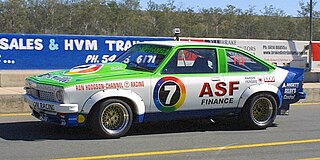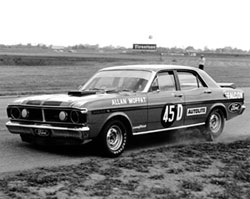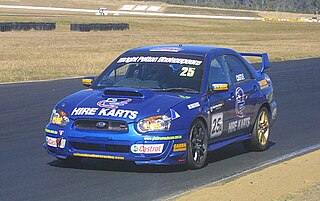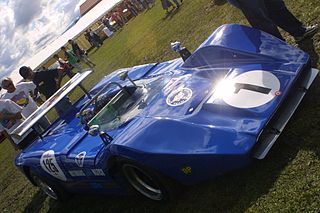
Group A is a set of motorsport regulations administered by the FIA covering production derived touring cars for competition, usually in touring car racing and rallying. In contrast to the short-lived Group B and Group C, Group A vehicles were limited in terms of power, weight, allowed technology and overall cost. Group A was aimed at ensuring numerous entries in races of privately owned vehicles.

Australian Formula 2, sometimes abbreviated to AF2 or ANF2, is a "wings and slicks" formula racing category in Australia. The category is one of Australia's oldest, dating back to 1964. The current format of AF2 was introduced in 1978. Brian Shead of Cheetah Racing Cars and Garrie Cooper of Elfin Sports Cars were largely responsible for the development of the format, which was devised to suit the needs of Australian drivers, most of whom had little or no sponsorship and had to bear the costs of racing out of their own pockets.

In relation to Australian motorsport, Group C refers to either of two sets of regulations devised by the Confederation of Australian Motor Sport (CAMS) for use in Australian Touring Car Racing from 1965 to 1984. These are not to be confused with the FIA's Group C sports car regulations, used from 1982 to 1992 for the World Endurance Championship / World Sports-Prototype Championship / World Sportscar Championship and the 24 Hours of Le Mans.
The National Sports Sedans Series, formerly the Australian Sports Sedan Championship, is a CAMS sanctioned national motor racing title for drivers of cars complying with Australian Sports Sedan regulations. This class, essentially a silhouette racing car class, caters for cars of essentially free construction but utilising some of the bodywork of a closed, series production vehicle.
The Australian Super Touring Championship was a CAMS-sanctioned national motor racing title for Super Touring Cars.

Australian Formula 3 has been the name applied to two distinctly different motor racing categories, separated by over twenty years.
The 1997 Australian Touring Car Championship was a CAMS sanctioned Australian motor racing title open to 5.0 Litre Touring Cars complying with Group 3A regulations. The championship, which was the 38th Australian Touring Car Championship, began on 15 March at Calder Park Raceway and ended on 3 August at Oran Park Raceway after 10 rounds.

Australian Formula 1 (AF1) was a motor sport category for open-wheeler racing cars which was current in Australia from 1970 to 1983.

The Australian National Formula was an Australian motor racing category which was introduced by the Confederation of Australian Motor Sport in 1964 and remained current until the end of 1969. It had replaced Formula Libre as the Australian premier racing formula.
The Australian Motor Racing Series is a collection of national motor racing series travelling to a series of circuits across Australia under a single banner. These race meetings represent the banner race meetings for the Australian Auto Sport Alliance who sanction the series through circuits aligned to the AASA. The series has since collapsed due to poor entry numbers.
Alan Mann Racing was a British motor racing team organised by Alan Mann, who was a part-time racing driver and team manager. The team ran a substantial part of the Ford works racing effort in Europe from 1964 to 1969, when it ceased operations. It was based in Byfleet, Surrey, near the Brooklands race circuit.

Appendix J Touring Cars was an Australian motor racing category for modified, production based sedans. It was the premier form of Touring car racing in Australia from 1960 to 1964.

Group E Series Production Touring Cars was an Australian motor racing category for production based sedans competing with limited modifications. It was current from 1964 to 1972.

Group 3E Series Production Cars is an Australian motor racing formula for production based cars competing with limited modifications. Group 3E cars formerly contested the Australian Manufacturers' Championship and Australian Production Car Championship titles and compete in the annual Bathurst 12 Hour and Bathurst 6 Hour endurance races.

The Group 2 racing class referred to regulations for cars in touring car racing and rallying, as regulated by the FIA. Group 2 was replaced by Group A in 1982.

Group A Sports Cars is an Australian motor racing category that CAMS formulated for sports car racing in Australia. Introduced in 1964, it continues today under the name Group 2A Sports Cars.
The Australian Super Six Touring Car Series, known originally as the Australian Saloon Car Series, is an Australian motor racing series for drivers of Group 3K Saloon Cars. The Saloon Car category was devised as a low cost amateur sedan racing formula which would potentially replace the ageing HQ Holden category. The original regulations were focused around large Australian sedans of early 1990s vintage with eligibility limited to VN and VP series Holden Commodores and the EA and EB series Ford Falcons. The regulations limited the cars to six cylinder versions rather than the V8 engined models, as the latter might make the category too similar to Commodore Cup. The cars are slightly modified from their road going versions, with an emphasis on safety for racing.
The 1965 Australian Drivers' Championship was a CAMS sanctioned Australian national motor racing title open to racing cars complying with the Australian National Formula or the Australian 1½ Litre Formula. The title was contested over a six race series with the winner awarded the 1965 CAMS Gold Star. It was the ninth Australian Drivers' Championship.
Group D Production Sports Cars was a CAMS motor racing category current in Australia from 1972 to 1981.
The 2005 Biante Models Cars Historic Touring Car Series was an Australian motor racing competition for Group N cars. It was recognised by the Confederation of Australian Motor Sport as a National Series.












